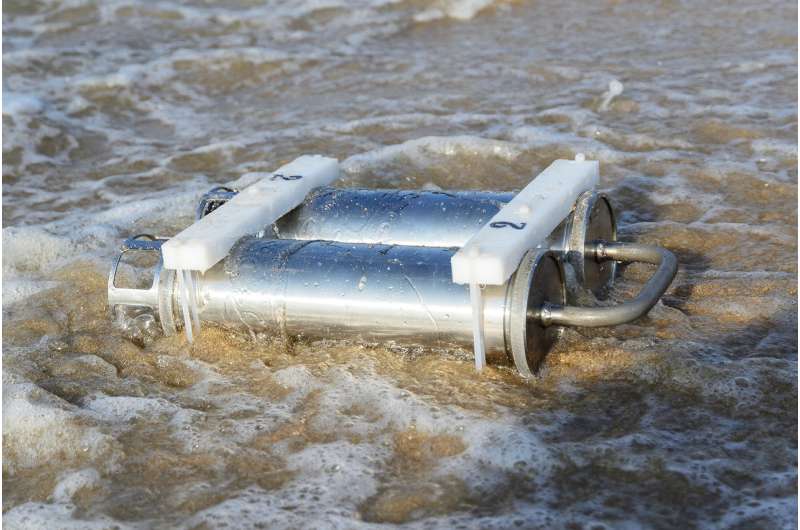New tool for oil and gas exploration beats all competition

The MIPT Center for Molecular Electronics (CME) has developed and tested a seismic station for hydrocarbon exploration. The new device has unparalleled bandwidth, enabling it to reveal the structure of underground reservoirs at a depth of up to several tens of kilometers. The seismic station can be used for onshore, transition-zone, and marine exploration. It can be deployed at depths of up to 0.5 kilometers, both in the Arctic and in the South Seas. The test findings were published in the Journal of Atmospheric and Oceanic Technology of the American Meteorological Society.
The standard technique used in hydrocarbon exploration worldwide is active seismic surveying. It involves the generation of seismic waves at the Earth's surface or underwater, which then penetrate soil or water, traveling tens of kilometers deep. When the reflected waves arrive back at the Earth's surface, they are picked up by seismic sensors. The reflected signal contains information about the location and properties of underground structures.
Vadim Agafonov, who heads the Center for Molecular Electronics at MIPT, describes the new device: "The seismic station that we developed can be mounted on the seafloor or on land for the purpose of conducting oil and gas exploration. It is a sealed module packed with its own power source, a range of highly sensitive seismic sensors developed by our team, and a signal recording system. The data collected by the sensors are written into a built-in storage unit. The station is equipped with interfaces for setting up the recording parameters, as well as downloading data and transmitting them to the central station for subsequent processing."
The station can pick up seismic signals containing data useful for hydrocarbon exploration. In general, shelf exploration involves the use of a network of stations positioned on the seafloor. Powerful air guns deployed on a ship blast compressed air to produce seismic waves. These waves travel toward the seafloor, penetrating into the ground. As a wave propagates further down, it bounces off the surfaces it encounters. A seismic station is capable of picking up the reflected signal for subsequent analysis. This reveals underground structures, including potential hydrocarbon reservoirs. The station can operate onshore, on ice, on rough terrain, and in transition zones where sea meets land. It is capable of withstanding hostile conditions, including temperatures as low as minus 30 degrees Celsius and as high as 65.
The data is transmitted to a central station in real time for subsequent processing. By contrast, those stations that are based on the seafloor accumulate data, which can be relayed to the central unit when the experiment is over. The station is designed to operate autonomously and is capable of continuously recording data for 30 to 60 days, depending on the recording parameters.

At the heart of the device are unique seismic sensors developed at MIPT. Each of these consists of a micron-sized node immersed in a liquid that has a high electrical conductivity. The seismic signal causes the liquid to move relative to an electrode, which affects the current between electrodes. The sensors are incorporated into the system, allowing the recorded signals to be digitized and stored on the internal drive.
The performance characteristics of the system are significantly superior to those of currently available analogues. The majority of similar seismic stations now in use feature electromechanical geophones with bandwidths of 10 to 250 Hertz. The sensors developed at CME have a bandwidth of 1 hertz, and receive low-frequency waves—the ones that travel the farthest. It is usually the case that marine and transition-zone exploration systems cannot be mounted onshore due to their weight and size. At the same time, land-based stations are not fit for offshore use because they are not watertight. The seismic sensor developed at MIPT is universal. It also incorporates cutting-edge circuitry and hardware components.
The field tests were conducted on the shore of the Sea of Azov in Krasnodar Krai, a territory in southwestern Russia. A network of 17 stations was installed on the seafloor, and a control station was mounted on the shore. The stations enabled the synchronized pickup of seismic and hydroacoustic signals at predetermined recording sites. In addition to routine data collection, the system proved sensitive enough to detect the 7 Aug. earthquake in Ukraine, despite being deployed 200 kilometers away from the epicenter. The seismic stations have thus proved their usefulness for seismic and seismological research on the seafloor and in transition zones, including the detection of low-frequency events such as regional earthquakes.
The device has already attracted the attention of Lukoil, Rosneft, and other companies.
More information: Journal of Atmospheric and Oceanic Technology of the American Meteorological Society, DOI: 10.1175/JTECH-D-16-0254.1
Provided by Moscow Institute of Physics and Technology















